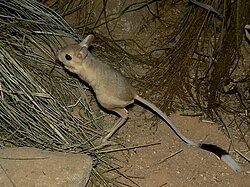
Dipodidae is a family of mammals in the order Rodentia and part of the Myomorpha suborder. Members of this family are called dipodids or jerboas. They are found in Asia, northern Africa, and eastern Europe, primarily in deserts, shrublands, and grasslands, though some species can be found in coastal areas or forests. They range in size from the Baluchistan pygmy jerboa, at 4 cm (2 in) plus a 7 cm (3 in) tail, to the great jerboa, at 23 cm (9 in) plus a 30 cm (12 in) tail. Dipodids are omnivores, and eat a variety of vegetation as well as insects, arachnids, and lizards. No dipodids have population estimates, but no species are categorized as endangered.
Contents
- Conventions
- Classification
- Dipodids
- Subfamily Allactaginae
- Subfamily Cardiocraniinae
- Subfamily Dipodinae
- Subfamily Euchoreutinae
- References
- Sources
The 33 extant species of Dipodidae are divided into 13 genera, divided into 4 subfamilies. Allactaginae contains 16 species in 4 genera, Cardiocraniinae contains 7 species in 3 genera, Dipodinae contains 9 species in 5 genera, and Euchoreutinae contains a single species. Several extinct prehistoric dipodid species have been discovered, though due to ongoing research and discoveries, the exact number and categorization is not fixed. [1]


















